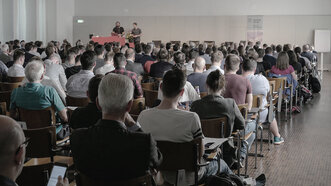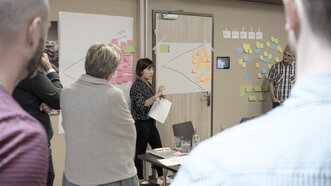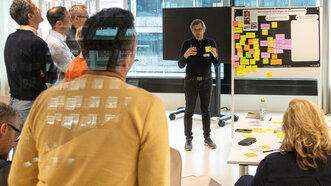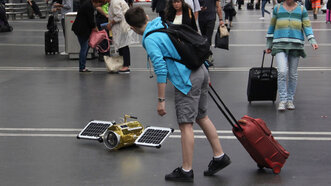This approach allows us to include both quantitative information and qualitative viewpoints. Future experiments should not only think about the future, but also turn it into reality. Together with a diverse range of people, we want to make bold hypotheses about what desirable futures might look like. And ultimately we will transform these hypotheses into objects, projects and exhibitions and thus make them tangible. In this way, futures become not only imaginable but also shapeable.
Future experiments
In order to make desirable futures a reality, we conduct future experiments. These allow us to negotiate, discuss and ultimately test scenarios of possible futures.
Even the future was better in the old days.
Karl Valentin
Understanding digital transformation
What challenges and potentials does digital transformation bring with it?
Recognize impact
Which social and technological developments will have an impact on us?
Develop scenarios
What would be desirable future scenarios and what possibilities for action do we have?
Shaping the futures
Which methods can be used to create groundbreaking future experiments?
I. Understanding digital transformation
What challenges and potentials does digital transformation bring with it? Without a common understanding of digital transformation and its effects on society and the economy, it is difficult to think about the future. This is why we create spaces and networks to learn and exchange new ideas.

II. Recognize impact
The second step is to apply the findings from the first step specifically to the respective problem or specific field of investigation. The aim is to understand how digitisation, in conjunction with other social trends, influences the field of action. In an environmental analysis, we will explore which technologies will shape the field of investigation in the future and which social developments need to be taken into account. These findings are bundled into hypotheses and allow for some initial projections of the future.
- Concept of the Smart City Lab - City of Zurich
- Mooh: Transparency in the dairy industry through block chain
III. Develop scenarios
When we understand what influences will change our field of action, we can imagine a spectrum of possible futures. Which of these will occur, no one can predict with certainty. But we can imagine scenarios that we consider desirable and those that we would rather avoid. In our work we concentrate on the desirable scenarios. We discuss what they look like and what options we have to move into this direction. This method allows us to detect negative tendencies at an early stage and to actively counteract them.

IV. Shaping the futures
Since scenarios are still abstract and speculative ideas, we would like to make them binding. Through the development of analog and digital prototypes, possible futures become tangible. At the same time they create space for experiments. The experiments usually raise new questions and uncertainties can be clarified. The future becomes more concrete and easier to understand for the observer. These both contribute to coming one step closer to the desired scenarios.

More future-oriented methods
Contact


